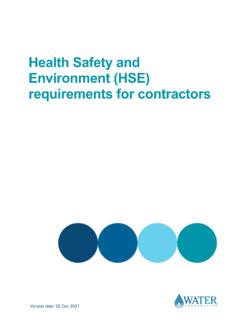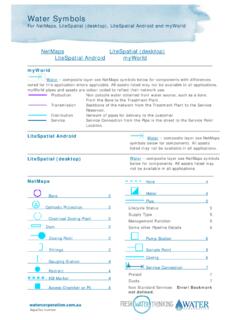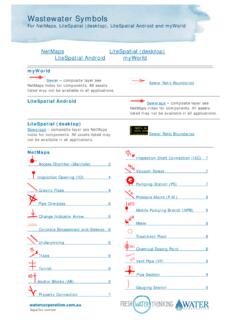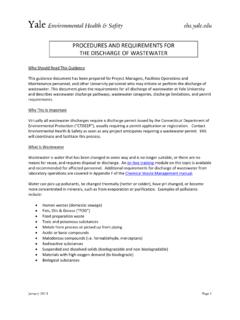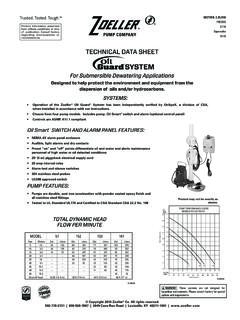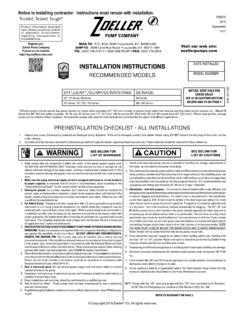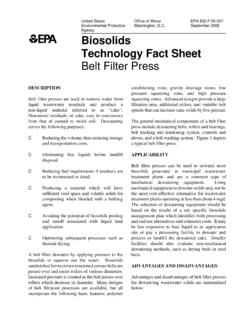Transcription of Technical Guidelines - Water Corporation
1 Technical Guidelines For safely working near Water Corporation assets 2 Revisions This guideline has been revised on the dates shown. Revision number Issue date Reason for change June 2017 Initial Issue June 2019 Annual update 3 Contents Revisions .. 2 1. Definitions .. 5 2. Introduction to working near our assets .. 6 Safety - Your Responsibility 6 Who to contact for support 7 3. Understanding our assets .. 8 Pipeline locations 9 Pipeline condition 9 Pipeline material 9 Pipeline fittings and structures 9 Water tanks and towers 10 Other assets 10 4.
2 Process for working near our assets .. 11 Dial Before You Dig 12 Site inspection 12 Conduct an Asset Protection Risk Assessment 12 Potholing 13 5. Requesting approval .. 14 When you need to request approval 14 How to request approval 16 6. Reducing risk .. 17 Redesign your work 17 Relocate our asset 17 Protect our asset 18 Permanent protection 18 7. Zones around our assets .. 24 Zone of influence 24 Building restriction zone 25 Zone of construction 26 8. Technical requirements for protecting our assets.
3 27 Single storey and multi-storey structures 27 Ground floor slabs 30 Above-ground floor slabs 31 Underground structures 32 4 Laying sewers in basements 33 Light weight structures 34 Fences and walls 35 Retaining walls 37 Ground anchors 38 Earthworks and alteration of surfaces 39 Ground cover 39 Pipeline fittings and structure 42 Other 42 Movement of heavy vehicles 43 dewatering 45 Vibrations 46 Excavations 48 Open excavations 48 Trenchless excavations 51
4 Service installations 53 Underground services 53 Overhead services 55 Road development 56 Road crossings 56 Planting and removing trees 58 Installing equipment on our assets 59 Key infrastructure 60 9. 61 Appendix 2: Zones around our assets for buildings and structures .. 64 Appendix 3: Guidelines for enclosing sewers in tunnels .. 75 5 1. Definitions In this guideline the following words and expressions have the following meanings. These meanings do not necessarily align with the meanings given in other Water Corporation publications or in legislation.
5 Alignment The line on which the pipes are laid and measured from the adjacent cadastral boundary. Approval Approval of a third party to conduct work in, on over, under or within the Prescribed Proximities to Water Corporation assets. Assets Includes any of our Water , wastewater and drainage assets, but in this guideline most commonly refers to Water pipelines, sewer pipelines and drainage pipelines and their associated fittings and structures. Damage Physical damage to and interference with our assets.
6 Damage includes coating or lining damage, dents, scratches, cracks, bending, displacement, perforation, ruptures, joint opening. Interference includes: preventing or restricting access for operation and maintenance. Damage can also include potential impacts that our assets can have on your works. Design engineer An engineer who is suitably qualified with appropriate engineering experience who is responsible for preparing design drawings and documents. Design standard Water Corporation s design standard relevant to the works being undertaken.
7 Prescribed Proximities The proximity, or proximities, to an asset, prescribed by Water Corporation under Section 90 of the Water Services Act 2012 within which approval is required before a person can undertake certain work. Risk The likelihood of work causing damage to our assets, as well as our assets causing damage to your work. Services Includes telecommunications cables, gas mains, power poles and cables, as well as Water , wastewater and drainage assets owned by other organisations. Third-party The individual, group of people or organisation that is undertaking work near Water Corporation assets.
8 Works The development of all types of buildings, structures and other obstructions (including residential buildings, pools, sheds, carports, major developments, transport infrastructure, services, stockpiles, ground anchors, trees, equipment installed on our assets), and any work that causes changes to the ground (including movement of heavy vehicles, blasting, pile driving, ground compaction, dewatering , earthworks, open and trenchless excavations). Zone of influence The zone of influence is an area extending both horizontally and longitudinally along a buried pipeline.
9 It is the area in which loads from buildings or structures on the surface may potentially cause damage to the pipeline. Settlement or disturbance of the ground within this zone may also cause damage to buildings or structures on the surface above. 6 2. Introduction to working near our assets We have developed this guideline to assist anyone who is planning or conducting work near our assets. This includes the development of buildings or structures and any work that causes changes to the ground, including.
10 Development of buildings, transport infrastructure and other structures earthworks and alteration of surfaces movement of heavy vehicles (other than on permanent roads) work causing excessive vibrations (such as blasting, pile driving, ground compaction) dewatering open and trenchless excavations installing ground anchors installing buried and overhead services planting and removing trees installing equipment on our assets (such as telecommunications antennas on Water tanks). These activities, and other similar activities, can cause damage to our assets which can be expensive, and highly disruptive to the community and hazardous to your employees and the general public.
